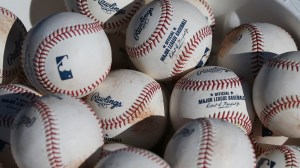Baby monitors that track infants’ vital signs might create more problems than they prevent. A review in the Journal of the American Medical Association says there is no “available evidence supporting the safety, accuracy, effectiveness or role of these monitors.”
7 month old Jordan Sell wasn’t always the healthy baby he is today. He was born six weeks early and his mother Jaime says his oxygen levels kept dropping during his stay in the neonatal intensive care unit. He was hooked up to monitors around the clock. Jordan was released after three weeks.
“We were concerned that not being hooked up to the monitors we couldn’t see his heart rate,” Jaime said. They bought an Owlet Baby Monitor against the advice of the NICU nurses
Jaime added, “We decided to go ahead and get it anyway. It was worth every penny,”
Devices like the Owlet are the focus of the JAMA Viewpoint. Authors specifically call out smartphone-linked wearables, like smart socks, onesies, and diaper clips. The devices measure babies’ biometrics like pulse rate and oxygen and send those measurements to parents’ apps.
In a statement, Owlet acknowledged a “lack of evidence behind certain products,” but said they are “actively addressing and resolving these concerns.”
“There is no evidence that they will help kids and there is some evidence of potential harm,” said Dr. Christopher Bonafide, pediatrician, Children’s Hospital of Philadelphia.
Dr. Bonafide co-authored the JAMA Review. He said there’s no way to prove their accuracy and they can lead to false alarms and unnecessary treatments.
“They could come into the emergency room. They may end up with blood tests, they may end up with x-rays,” he explained.
But because the companies don’t make specific medical claims, they are not regulated by the FDA.
“We are not saying that we are a SIDS monitor at all,” said Baby Vida Co-founder Mollie Evens.
Mollie and her husband Jeff created the Baby Vida Monitor after their twin baby girls contracted RSV, an infection that causes breathing trouble. Doctors told them to check the infants’ breathing every 45 minutes.
Mollie said, “We thought, well, what happens between 0 and 45 minutes.”
They enlisted a team of engineers and designed a sock with sensors that monitor oxygen levels and heart rate. She explained, “We said that if we saved one child’s life in being able to create this product for somebody that it was worth it.”
Dr. Bonafide said while he doesn’t advise it, he urges parents who do choose to use these monitors to use tried and tested recommendations for SIDS prevention, such as always having your baby sleep on their back, and leaving nothing else in the crib like blankets or stuffed animals.
The American Academy of Pediatrics has also advised against the monitors stating, “do not use home cardiorespiratory monitors as a strategy to reduce the risk of SIDS”, one of the leading causes of infant mortality.
